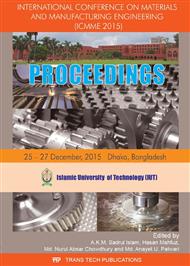[1]
Md. Safiuddin, Mohd Zamin Jumaat, M. A. Salam, M. S. Islam and R. Hashim, Utilization of solid wastes in construction materials, International Journal of the Physical Sciences, Vol. 5(13), pp.1952-1963, 18 October, (2010).
Google Scholar
[2]
Tanvir Hossain, Shuronjit Kumar Sarker, B.C. Basak, Utilization Potential of Rice Husk Ash as a Construction Material in Rural Areas, Journal of Civil Engineering (IEB), Vol. 39(2), pp.175-188, (2011).
Google Scholar
[3]
Hwang Chao-Lung, Bui Le Anh-Tuan, Chen Chun-Tsun, Effect of Rice Husk Ash on The Strength and Durability Characteristics of Concrete, J Construction and Building Materials, Vol. 25, p.3768–3772, (2011).
DOI: 10.1016/j.conbuildmat.2011.04.009
Google Scholar
[4]
J.E. Oti, J.M. Kinuthia, R.B. Robinson, The Development of Unfired Clay Building Material Using Brick Dust Waste and Mercia Mudstone Clay, Applied Clay Science, Vol. 102, pp.148-154, (2014).
DOI: 10.1016/j.clay.2014.09.031
Google Scholar
[5]
Farid Debieba, Said Kena, The Use of Coarse and Fine Crushed Bricks as Aggregate in Concrete, Construction and Building Materials, Vol. 22(5), pp.886-893, (2008).
DOI: 10.1016/j.conbuildmat.2006.12.013
Google Scholar
[6]
F. Bektas, K. Wang, H. Ceylan, Effects of Crushed Clay Brick Aggregate on Mortar Durability, Construction and Building Materials, Vol. 23(5), pp.1909-1914, March (2009).
DOI: 10.1016/j.conbuildmat.2008.09.006
Google Scholar
[7]
Paulo B. Cachim, Mechanical Properties of Brick Aggregate Concrete, Construction and Building Materials, Vol. 23(3), pp.1292-1297, March (2009).
DOI: 10.1016/j.conbuildmat.2008.07.023
Google Scholar
[8]
Guilia Baronio and Luiga Binda, Study of the Pozzolanicity of Some Bricks and Clays, Construction and Building Materials, Vol. 11(1), 1997, pp.41-46, (1997).
DOI: 10.1016/s0950-0618(96)00032-3
Google Scholar
[9]
M. S. Sultana, M. I. Hossain, M, A. Rahman and M. H. Khan, Influence of Rice Husk Ash and Fly Ash on Properties of Red Clay, Journal of Scientific Research, Vol. 6(3), pp.421-430, (2014).
DOI: 10.3329/jsr.v6i3.15343
Google Scholar
[10]
Houstin DF. Rice chemistry and technology. Minnesota: American Association Of Cereal Chemists, p.301–40, (1972).
Google Scholar
[11]
Rogers, Sara B. (2011). Evaluation and Testing of Brick Dust as a Pozzolanic Additive to Lime Mortars for Architectural Conservation. (Master's Thesis). University of Pennsylvania, Philadelphia, PA.
Google Scholar
[12]
Gurchan Singh, Building Materials, pg. 53.
Google Scholar
[13]
Sugita, On the Economic production of Large Quantities of Highly Reactive Rice Husk ash, International symposium on innovative world of Concrete (ICI-IWC-93), Vol. 2, pp.3-71, (1993).
Google Scholar


